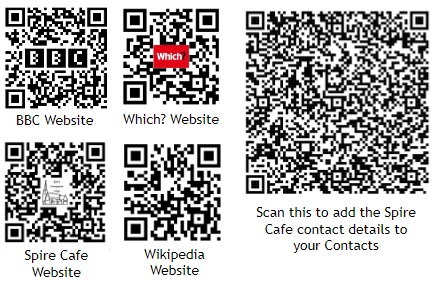QR codes are all over the place at the moment. You may have spotted these little black and white squares outside your favourite restaurant, or if picking up an order from Tesco. Their use rapidly increased during the pandemic as people checked in at a venue or reported a covid test. The technology isn’t exactly new (these Quick Response codes have been around since 1994), but QR codes are now more important than ever before.

But what are QR codes and how do we use them?
QR codes are the next generation of barcodes. They contain far more information than a barcode and can be scanned in any direction, sideways, upside down, making them far more flexible. Most QR codes are simply a link to a website, but some other applications allow you to …
- Connect to a WI-FI or share a WI-FI connection with others.
- Send a message by Email, SMS or Whatsapp.
- Call a phone number.
- Share your’s or someone else’s contact details from your phone, or on a business card.
- Sign up for an event.
- Pay for something.
- … and many more.
QR codes are dynamic, which means they don’t have to connect you to a static website for instance, they could use the date, time, your location or even the weather to send you to appropriate information for the time of day or weather. For example, if you were scanning a QR code in a bar or restaurant it could direct you to the appropriate menu for the time of day, or a choice of summer or winter menus or drinks depending on the weather or season.
QR codes also allow marketing departments to track and analyse the use of their QR code campaigns, for example tracking the number of scans, scan locations, scan times, and devices used. Marketing people can then use that information to improve on their marketing strategies.
Most modern smartphones have a QR code reader built in, either in the camera app, or in a separate scanning app. If you have an older smartphone that doesn’t have an inbuilt scanning app, you can download a free one from your app store. For Android phones I would recommend “QR Code and Barcode Reader by QR Scan Team”, or “Google Lens” that has plenty of other features to unlock the power of your Smartphone too! For iOS I would recommend “QR Reader for iPhone”, which again has plenty of other features.
To scan a QR code, simply open your camera or QR code reader app and point it at the QR code. Simple as that!
Then, it depends on what you are scanning. It will display the details contained in the QR code and may ask you if you want to go to the website, connect to a Wi-Fi or add a contact for example. But in Most instances, it will show you a website address with a prompt to open or goto the website.
Most modern smartphones allow you to share a Wi-Fi that you are connected to, for instance, your home router. So, if you get a visitor that need to connect to your Wi-Fi, go into the settings on your phone, look for your Wi-Fi connection and see if it gives you the option to ‘share’. Tap the button and it will display a QR code on your screen. Your visitor simply scans the QR code to connect to your network. No more entering passwords! You can share contacts in a similar way.
But, are QR codes safe and are there any risks in using them?
Because they are new, people have confidence in QR codes and assume they are safe, but like anything new, scammers have wasted no time in exploiting the technology behind them for their own gain. There is no risk in using a legitimate QR code, but if you are using a QR code in a public place, there is always the possibility the code may have been tampered with, for instance a new code may have been pasted over the original which will take you to a phishing website. This is called Quishing (QRishing) or QR Jacking. Instances of this have been seen on parking machines and electric charging points, anywhere that collects payments and you will expect to have to enter your credit card details.
Also, just like scammers can send an email with a fraudulent link, they can also send fraudulent QR codes by email or in the post. So what can we do to make sure we don’t fall foul of a SCAM when using a QR code?
- Don’t scan it! If anything feels off, don’t scan the QR code. Just go to the actual website directly. Any legitimate QR code should have an associated URL under it, giving users the option to navigate there directly. If it’s missing, beware.
- Inspect QR code URLs closely. After scanning the QR code, check out the URL it directs you to before proceeding. Does it match the organisation associated with the QR code? Does it seem suspicious, or include strange misspellings or typos? If your QR code reader does not show the URL, download one that does.
- Look for signs of physical tampering. This is especially important in places where QR codes are commonly used, such as restaurants. If you spot a QR code sticker adhered to a page over another code, be very sceptical.
- Never download apps from QR codes. Always go to the official app store for your device.
- Don’t make electronic payments via QR codes. Use the native app or direct a browser to the official domain and log in there.
- For extra peace of mind, use a QR code scanner from cybersecurity experts Trend Micro or Kaspersky. You will find these free to use in the app stores and they will check the security of every QR code you scan, providing a warning whenever it encounters a dodgy link.


